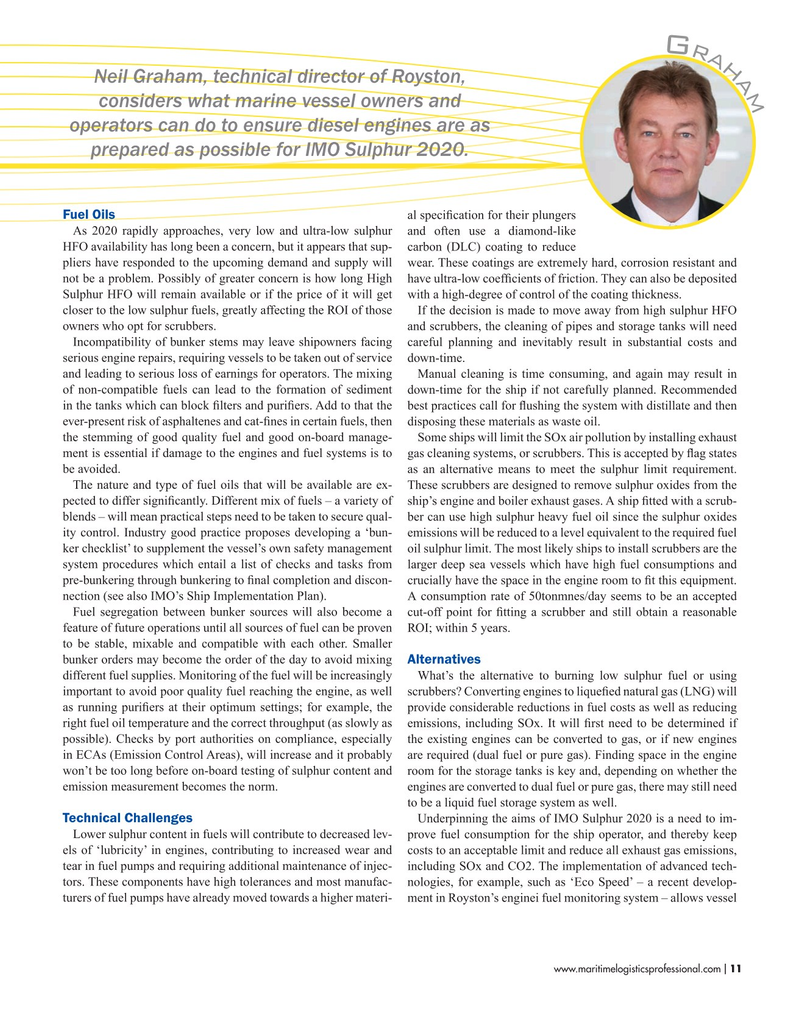
Page 11: of Maritime Logistics Professional Magazine (Nov/Dec 2019)
Short Sea Shipping Ports
Read this page in Pdf, Flash or Html5 edition of Nov/Dec 2019 Maritime Logistics Professional Magazine
G r a h a
Neil Graham, technical director of Royston, m considers what marine vessel owners and operators can do to ensure diesel engines are as prepared as possible for IMO Sulphur 2020.
Fuel Oils al specifcation for their plungers
As 2020 rapidly approaches, very low and ultra-low sulphur and often use a diamond-like
HFO availability has long been a concern, but it appears that sup- carbon (DLC) coating to reduce pliers have responded to the upcoming demand and supply will wear. These coatings are extremely hard, corrosion resistant and not be a problem. Possibly of greater concern is how long High have ultra-low coeffcients of friction. They can also be deposited
Sulphur HFO will remain available or if the price of it will get with a high-degree of control of the coating thickness.
closer to the low sulphur fuels, greatly affecting the ROI of those If the decision is made to move away from high sulphur HFO owners who opt for scrubbers. and scrubbers, the cleaning of pipes and storage tanks will need
Incompatibility of bunker stems may leave shipowners facing careful planning and inevitably result in substantial costs and serious engine repairs, requiring vessels to be taken out of service down-time. and leading to serious loss of earnings for operators. The mixing Manual cleaning is time consuming, and again may result in of non-compatible fuels can lead to the formation of sediment down-time for the ship if not carefully planned. Recommended in the tanks which can block flters and purifers. Add to that the best practices call for fushing the system with distillate and then ever-present risk of asphaltenes and cat-fnes in certain fuels, then disposing these materials as waste oil. the stemming of good quality fuel and good on-board manage- Some ships will limit the SOx air pollution by installing exhaust ment is essential if damage to the engines and fuel systems is to gas cleaning systems, or scrubbers. This is accepted by fag states be avoided. as an alternative means to meet the sulphur limit requirement.
The nature and type of fuel oils that will be available are ex- These scrubbers are designed to remove sulphur oxides from the pected to differ signifcantly. Different mix of fuels – a variety of ship’s engine and boiler exhaust gases. A ship ftted with a scrub- blends – will mean practical steps need to be taken to secure qual- ber can use high sulphur heavy fuel oil since the sulphur oxides ity control. Industry good practice proposes developing a ‘bun- emissions will be reduced to a level equivalent to the required fuel ker checklist’ to supplement the vessel’s own safety management oil sulphur limit. The most likely ships to install scrubbers are the system procedures which entail a list of checks and tasks from larger deep sea vessels which have high fuel consumptions and pre-bunkering through bunkering to fnal completion and discon- crucially have the space in the engine room to ft this equipment. nection (see also IMO’s Ship Implementation Plan). A consumption rate of 50tonmnes/day seems to be an accepted
Fuel segregation between bunker sources will also become a cut-off point for ftting a scrubber and still obtain a reasonable feature of future operations until all sources of fuel can be proven ROI; within 5 years.
to be stable, mixable and compatible with each other. Smaller bunker orders may become the order of the day to avoid mixing
Alternatives different fuel supplies. Monitoring of the fuel will be increasingly What’s the alternative to burning low sulphur fuel or using important to avoid poor quality fuel reaching the engine, as well scrubbers? Converting engines to liquefed natural gas (LNG) will as running purifers at their optimum settings; for example, the provide considerable reductions in fuel costs as well as reducing right fuel oil temperature and the correct throughput (as slowly as emissions, including SOx. It will frst need to be determined if possible). Checks by port authorities on compliance, especially the existing engines can be converted to gas, or if new engines in ECAs (Emission Control Areas), will increase and it probably are required (dual fuel or pure gas). Finding space in the engine won’t be too long before on-board testing of sulphur content and room for the storage tanks is key and, depending on whether the emission measurement becomes the norm. engines are converted to dual fuel or pure gas, there may still need to be a liquid fuel storage system as well.
Technical Challenges
Underpinning the aims of IMO Sulphur 2020 is a need to im-
Lower sulphur content in fuels will contribute to decreased lev- prove fuel consumption for the ship operator, and thereby keep els of ‘lubricity’ in engines, contributing to increased wear and costs to an acceptable limit and reduce all exhaust gas emissions, tear in fuel pumps and requiring additional maintenance of injec- including SOx and CO2. The implementation of advanced tech- tors. These components have high tolerances and most manufac- nologies, for example, such as ‘Eco Speed’ – a recent develop- turers of fuel pumps have already moved towards a higher materi- ment in Royston’s enginei fuel monitoring system – allows vessel www.maritimelogisticsprofessional.com 11
I

 10
10

 12
12
